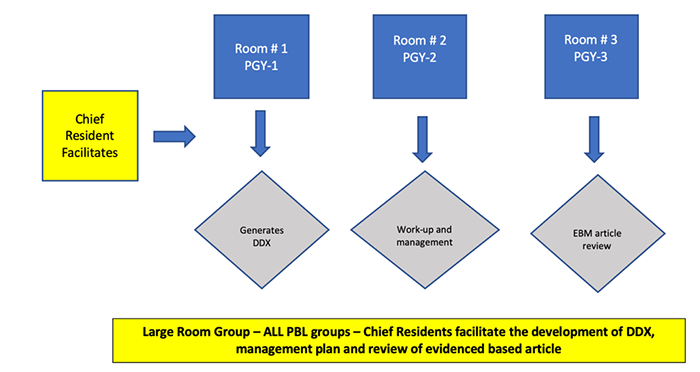Teaching Methodology Utilized for Educational Activities
We intentionally de-emphasize the use of traditional power point didactics and focus on active learning strategies with integration of teamwork and collaboration. Our educational activities are designed to incorporate small group learning with various activities that promote facilitated learning and independence. Some examples of our teaching methodologies include:
Team Based Learning (TBL) and Problem Based learning (PBL) – this are instructional strategies that focus on procedures for developing high performance learning in teams. These structured processes promote critical thinking, a problem-solving approach, and collaboration with peers. We often use a hybrid or a blended model for various activities during the Academic Wednesday activities.
We enjoyed using the TBL model during simulation education our patient safety curricula:
Goolsarran N, Hamo CE, Lane S, Frawley S, Lu WH. Effectiveness of an interprofessional patient safety team-based learning simulation experience on healthcare professional trainees. BMC Med Educ. 2018;18(1):192. Published 2018 Aug 8. doi:10.1186/s12909-018-1301-4
Jigsaw model – This is a research based cooperative learning technique in which each “expert” group specializes in a particular aspect of a broader topic. After mastering the materials, residents experts return to their “home” groups and teach the material to their group members. The ultimate goal is to solve an issue as team after “expert” learning and discussion.
We utilized the jigsaw model for our Patient Safety and Women’s Health curricula:
Goolsarran N, Hamo CE, Lu WH. Using the jigsaw technique to teach patient safety. Med Educ Online. 2020;25(1):1710325. doi:10.1080/10872981.2019.1710325
Ng, P, Kranz, K, Abeles, R, Schwartz, D, Lane, S. Using the Jigsaw Teaching Method to Enhance Internal Medicine Residents’ Knowledge and Attitudes in Managing Geriatric Women’s Health. Accepted for publication as “Editor’s Choice” in MedEdPORTAL, June 2020
Think-Pair-Share – this is a collaborative learning strategy in which residents work in pairs to solve a problem or answer a particular clinical question. This strategy requires residents to (1) think individually about an answer to a question; then (2) share ideas with each other; and (3) share ideas in large group with other peers. We frequently utilize this strategy during resident report to allow our residents to critically analyze management plans. This strategy promotes activation of prior knowledge and helps to create a positive and supportive learning environment.
Case method teaching – This is a well-established teaching approach that is used across many disciplines. We frequently conduct learning that is centered around case studies or various clinical scenarios. This strategy helps our residents to develop skills in analytic thinking and reflective judgment by reading and discussing complex clinical scenarios.
Roundtable discussions/reflections – We frequently integrate the use of round table discussions and reflections to create meaningful discussions around various topics in healthcare. This strategy is particularly used when we discuss challenges and barriers to health equity. We use this technique when we “debrief the grief” around patient death and its emotional impact on a resident’s well-being.
Resident Report
Our resident report takes place daily from 1-2pm. We utilize an active learning methodology to engage residents in small group learning and discussion. A clinical vignette of a patient is usually presented by a resident during the first 30 minutes. Our chief residents facilitate group discussion on differential diagnosis, workup and patient management. Faculty members are present to provide expert input and best practice suggestions relevant to the case. The presenting resident gives a short summary of key learning points and a PICO-formatted summary of article from the literature that is relevant to the case. Resident report concludes with 1-2 related MKSAP questions to underscore key points for ABIM board preparation.
To maintain our program’s emphasis on interactive and engaging group learning activities during the pandemic, our resident report, part of our virtual education program, is called CLEVR – Collaborative Learning Environment Virtual Report. This model is focused on facilitated learning with small group activities that enable residents to: (1) analyze and synthesize clinical patient data; (2) generate relevant differential diagnoses; (3) suggest diagnostic work-up and management plans with supporting rationale and justification; and (4) appraise the relevant evidence based guidelines with application to the clinical case.
CLEVR report begins with resident presentation of a clinical vignette of a patient encounter. This is followed by facilitated small group activities followed by summary of learning points.


